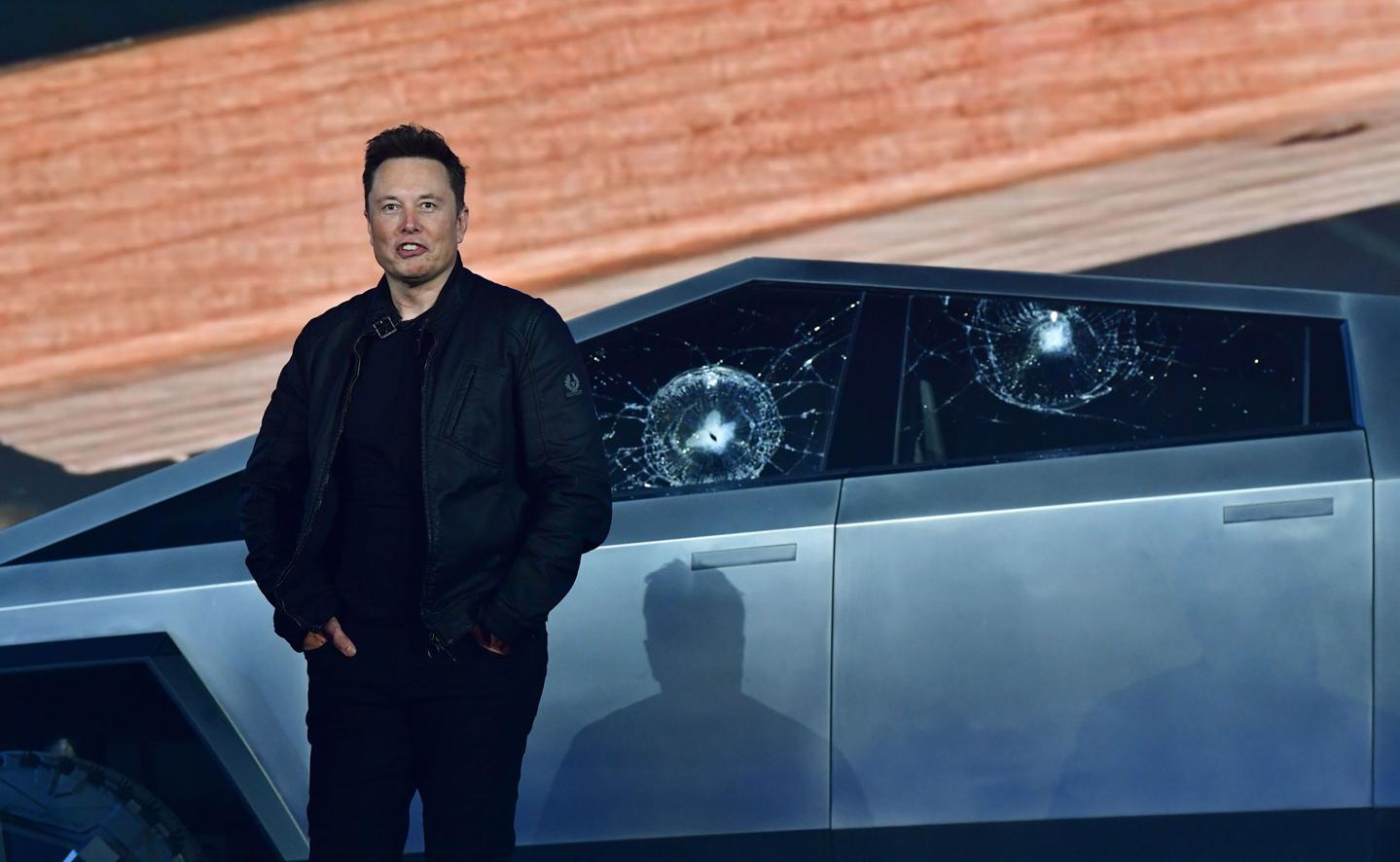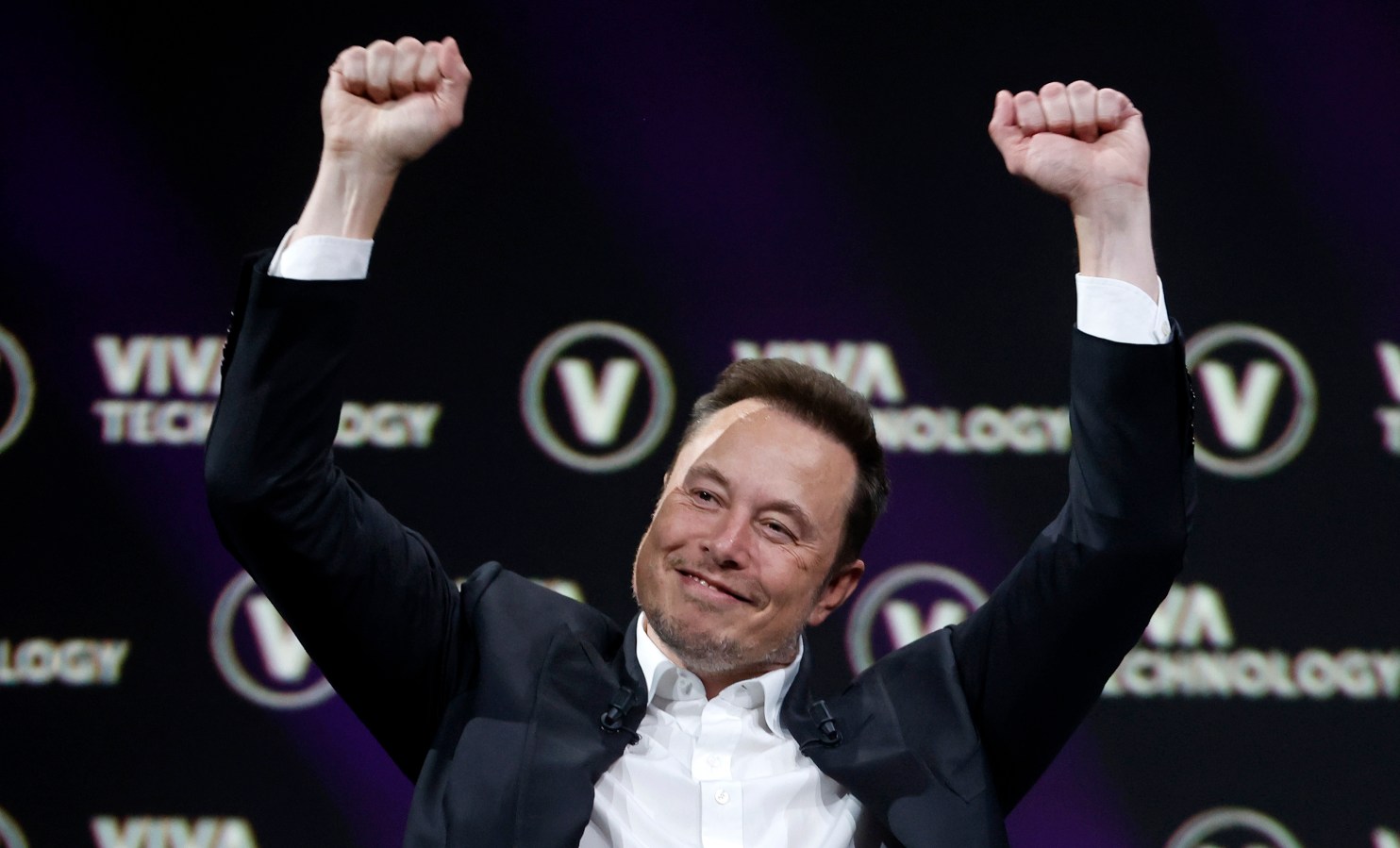Elon Musk’s hard-edged electric reinterpretation of the pickup truck excites his fans, puzzles auto experts and seems “ludicrous” and unnecessary to environmentalists.

Elon Musk at Cybertruck’s 2019 unveiling — after its “armor glass” windows failed a public test.
Frederick J. Brown_/FP/Getty Images
Elon Musk’s vision for Tesla in a 2006 manifesto, before he was its CEO and sole decision maker, thrilled environmentalists: fight carbon pollution with electric vehicles by starting with a pricey, open-top sports car and then shifting to affordable family models — ideally powered by the sun. Seventeen years later, his pitch for the big, blocky Cybertruck, expected to go on sale in the coming weeks, has nothing to do with the climate crisis.
“Cybertruck is built with an exterior shell made for ultimate durability and passenger protection,” a company webpage crows. “Starting with a nearly impenetrable exoskeleton, every component is designed for superior strength and endurance, from Ultra-Hard 30X Cold-Rolled stainless-steel structural skin to Tesla armor glass.” Tesla also claims the heavy EV can “pull near infinite mass.” (“Obviously, no vehicle, not even a Class-8 semi, can pull infinite mass,” said Ed Kim, president of industry researcher AutoPacific.)
There’s no reference to any environmental benefit on the website — and no details about Cybertruck’s on-sale date, price, weight and driving range per charge. “It’s no small car,” Musk said in a recent conference call, promising the truck would be out this year. He also claimed demand for it is “so far off the hook you can’t even see the hook,” without offering details. Tesla did not respond to a request for comment.
Tesla also hasn’t said how many people have paid $100 to reserve one, though fansites guess more than 1.5 million people have since its November 2019 unveiling (when design chief Franz von Holzhausen embarrassingly shattered the truck’s supposedly indestructible armor glass with heavy metal balls). How well it will sell isn’t certain, but one thing is: environmentalists hate it.
“The same poor thinking that infects the Hummer EV infects the Cybertruck,” Dan Becker, director of the Center for Biological Diversity’s Safe Climate Transport Campaign, told Forbes. “I’m not one of the people who’ve been cheering to see it. In fact, I’d be happy for it not to appear.”
The volatile multibillionaire’s push into pickups has less to do with environmental benevolence than the bottom line: the work-oriented vehicles are the U.S. auto market’s biggest and most lucrative segment. Americans bought about 2 million pickups last year, selling for an average of $59,000 last year. So if Tesla were to sell at least 100,000 Cybertrucks annually for $60,000 or more, the company could see more than $6 billion in additional annual revenue, assuming it sells — but that may be a stretch.
“It’s hard for me to get excited about (Cybertruck) from a climate perspective.”
Musk may expect some love from environmentalists simply by offering a large pickup powered by electricity, not carbon-spewing gasoline or diesel. Researchers at Argonne National Laboratory who developed a technique for assessing a vehicle’s lifetime carbon emissions and energy intensity say even an EV weighing more than 8,000 pounds with a massive battery pack can be less harmful to the planet than a similar-size truck running on fossil fuels over tens of thousands of miles of use. That’s because traditional pickups usually only get about 16 or 17 miles per gallon.
Yet the large amount of energy, aluminum and mined materials needed to build the Cybertruck seems to be at odds with Musk’s old climate-preserving principles. And while mined battery materials eliminate tailpipe emissions, extracting them has environmental harms, including groundwater pollution from mining scraps and chemicals, and human costs, such as when underage labor is used at cobalt mines in Congo.

A Tesla Cybertruck on display at the Petersen Automotive Museum in Los Angeles in 2020.
Robyn Beck/AFP/Getty Image
“It’s hard for me to get excited about (Cybertruck) from a climate perspective. Its benefits are murky at best if some purchasers would’ve otherwise bought a more modest-sized vehicle,” said transportation researcher David Zipper, a visiting fellow at the Harvard Kennedy School’s Taubman Center.
‘Nobody Gets A Hall Pass’
Ford, which has dominated the pickup segment for decades with its F-150, beat Tesla to market with its battery-powered F-150 Lightning, aimed at both pickup fans and commercial customers. So far, it’s the electric truck leader. GM is about to roll out its electric Chevy Silverado and late next year Stellantis will start selling the RAM 1500 REV that promises up to 500 miles of range per charge for a high-end version. Customers looking for a non-traditional truck can also get an electric R1T from upstart Rivian, a sporty model the company promotes for camping and beach trips with friends and that features distinctive concave headlights that create a friendly face. It’s a far cry from the menacing profile of Cybertruck, which looks like it was inspired by the brutalist architecture movement of the post-World War II years and designed for drives through a post-apocalyptic wasteland. (Tesla’s designers mostly “hated it,” von Holzhausen told Musk biographer Walter Isaacson.)
GM’s original Hummer proved long ago that controversial looks appeal to some buyers. Still, Cybertruck’s sales will be determined by how good a pickup it is, said Eric Noble, president of industry consulting firm The Carlab.
“Pickup trucks’ success or failure in the North American market is above all else, based on their ability to meet the duty cycle,” he said. That means in terms of cargo capacity, hauling and towing, “pickup buyers are willing to compromise exactly zero. Nobody gets a hall pass.”
Bullish Tesla analysts such as Wedbush’s Dan Ives think the company could sell at least 150,000 Cybertrucks in 2024 — and maybe up to 250,000 if the production ramp-up goes smoothly. Noble isn’t so sure there’s that big a market for a niche pickup, pointing to the overall sales of the Rivian R1T: fewer than 2,000 sales per month this year through July, according to Automotive News, citing Experian data.
“Here’s the interesting thing about the idea that (Cybertruck) is a niche, fashion statement vehicle. That’s what the Rivian R1T is,” he said. “It won’t meet the duty cycle of a regular pickup, but it’s good as an EV.”
Tesla’s fanbase may be excited but lackluster consumer views about Cybertruck suggest it faces headwinds. It ranked lowest among potential buyers of electric pickups surveyed by Cox Automotive in terms of what they were most interested in. Ford’s F-150 Lightning led the survey, followed by Dodge’s Ram EV, Chevrolet’s electric Silverado and Rivian’s pickup.
“Our studies continue to show the importance of brand strength, and that is particularly true in the full-size pickup truck segment, where brand loyalty often runs deep and fierce,” said Vanessa Ton, Cox’s senior manager of market and customer research. “This fact makes it particularly challenging for brands like Tesla and Rivian, both newcomers to the pickup segments.”
‘A Ludicrous Vehicle’
The lack of details Tesla has shared about Cybertruck so far prevents an accurate assessment of its environmental friendliness. It’s still unclear whether it’s had to put more raw materials or engineering into its blocky body shape or to align its stainless steel body panels in the manufacturing process.
Potentially, it could cut carbon emissions by about 50% over a lifetime of use, assuming a buyer replaces a similarly sized gasoline truck, said Nick Molden, CEO and founder of Emissions Analytics, an independent automotive research firm based in the U.K. But if an owner uses it less frequently than the gasoline truck, “that would undermine the climate benefit because the manufacturing emissions to make a Cybertruck would be amortized over too few miles,” he said.
“It doesn’t look like a vehicle you would want to be hit by.”
And while it may produce less carbon pollution, it’s not an emission-free vehicle. That’s because heavy EVs appear to create more harmful tire dust than conventional vehicles, said Molden, whose company researches that problem. A hazardous chemical treatment typically used on tires is linked to declining salmon populations in the U.S. and tire dust is seen as an unregulated contributor to lung and heart disease.
“The tire wear is likely to be substantially greater due to the added weight, and most of this will be created under acceleration, braking and cornering,” he said. “Then there are other factors such as safety — it doesn’t look like a vehicle you would want to be hit by.”
As it stands right now, Cybertruck doesn’t appear to meet safety regulations for pedestrians and cyclists in the European Union and probably can’t be sold there in its current form.
“I find it very hard to look past the danger its design poses to pedestrians and cyclists. I see no reason why reducing GHG requires a tradeoff with road safety,” Zipper, the transportation researcher, told Forbes.

The Cybertruck is on display at Tesla’s Giga Texas manufacturing plant in Austin, Texas. –
AFP via Getty Images
Advocates like Becker have railed for decades against the auto industry’s shift from smaller cars to ever-bigger, more profitable pickups and SUVs with less stringent government fuel economy requirements. He sees Cybertruck as part of the market’s overall “truckification” — and just plain weird.
“I find Cybertruck puzzling, sort of a conundrum on wheels because it’s also not like anything else,” he said. “But it’s coming from the guy who spent $40-something billion on Twitter only to drive it into the ground. He’s not like anybody else. I’m no psychiatrist, but I can tell you that this is a ludicrous vehicle.”
This article was first published on forbes.com and all figures are in USD.


